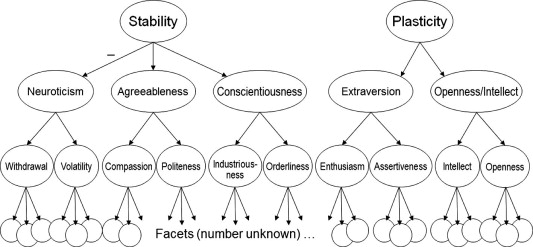Most people think that players have personality in just the same way you and I have a personality. But personality doesn’t exist. Our languages confuses personality with evolutionary behavioral patterns. This has been found out by professor DeYoung with his Cybernetic Big Five Theory. (CBFT)
The Big Five Theory is the most accepted scientific way of looking at personality. A lot of football clubs use the Big Five. What the Big Five does, is reduce all personality traits to the following five basic terms:
- Agreeableness, which measures how social you are.
- Extraversion, which measures how willing you are to take risks.
- Conscientiousness, which measures how goal orientated you are.
- Openness towards experience or openness towards reasoning.
- Neuroticism, which measures how easy you can be stressed.
While a lot of the research into the Big Five can be questioned, DeYoung did something interesting. He made brain scans of people who had the same score on a Big Five test and found that these people had the same neurological structures inside their head. There are thousands of different types of brain cells all with different quantities of receptors. Basically, if you have a lot of Dopamine receptors, it is much more likely that you score high on Extraversion, Conscientiousness and Openness for experience. If you have a lot of Oxytocin receptors, you are more likely to score high on Agreeableness.
From these findings DeYoung built his Cybernetic Big Five Theory, which shows that all of this has nothing to do with what we ordinarily call personality, but has everything to do with evolutionary behavioral patterns. The two main theories about how the brain learns, associative learning and instrumental learning, both start with the brain as a blank learning machine. But this goes against evolutionary thinking. DeYoung shows that the brain is not a blank learning machine, but that evolution has already specialized our brains into different brain types. Again, we talk about this as if this is our personality, but in reality these are different sets of behavioral patterns as they came out of evolution.
For football clubs these evolutionary behavioral patterns are extremely important as these different sets of behavior are explained as goals in terms of Cybernetic Big Five Theory. The evolutionary goals of your brain interfere with the goals your manager gave you as a player to achieve on the pitch.
To make it more concrete, I translated these patterns into the following archetypical players:
- Perfectionist (Guardiola)
- Helper (Ronaldo)
- Successful Worker (Gullit)
- Romantic (Romario)
- Analyst (Van Basten)
- Loyalist (Casarino)
- Hedonist (Maradona)
- Boss (Suarez)
- Mediator (Messi)
So next time you think about the personality of a player, it is better to see what typical behaviors you can find that match one of the archetypical players above.
So for coaches and managers it is important to know which CBFT type their players are. Because not only do their typical evolutionary behavioral patterns give your players goals that might interfere with the goals you set for them, players who have a different CBFT type will also have different kinds of these goals.
DeYoung makes clear that people’s evolutionary behavioral patterns means that they differ in regard to:
- Emotion
- Motivation
- Cognition
- External behavior
How personality confuses managers
Managers steer their team mostly based on their intuitions. For instance, while most of the players for the starting XI are obvious choices, some players only play because the manager has a good feeling about them. Using your intuition is a great way to excel as your Bayesian brain uses intuition to inform you of unconscious decision making. But sometimes intuitions go wrong because the unconsciousness of the manager is reacting to something different than the manager thinks. This happens with certain combinations of Cybernetic Big Five types.
For example, in the 16/17 season Peter Bosz played Veltman as right back far more often than Tete, while most people considered Tete a much better player for that position at that time. At the same time, because there is no clear cut choice between Veltman and Tete for that position, the manager had to rely on his intuitions. Yet, in this case it is highly likely that Bosz’ choice for Veltman had more to do with incompatibilities in the evolutionary behavioral patterns between Bosz and Tete than a sound intuition based on the quality of play of both players. Veltman and Bosz are probably much more compatible.
If this turns out to be the case, then the differences between Tete’s brain and the brain of Bosz produced a bad feeling in Peter Bosz that he mistook for an intuition to start with Veltman rather than Tete. Ajax lost that season to Feyenoord with only a one point difference. So it could very well be that not knowing about differences in evolutionary behavioral patterns have cost Ajax the championship that year. Cybernetic Big Five Theory is that important.
